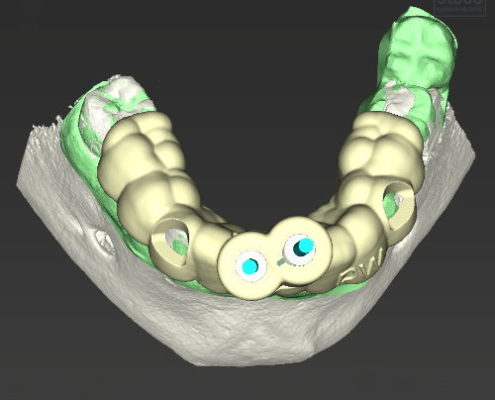Teeth with pulp canal calcification (PCC) are a challenge in root canal treatment since this is very hard to control, even under mircroscope.
Define drill axis with Software
Basing on 3D X-Ray data (CBCT) structures of calcificated teeth can be diagnosed and estimated virtually on screen. This can be done with software programs known from implant planning which usually uses DICOM data. The access to cavity and the drill axis can be planned virtually. Visualization of the drill bit geometry is helpful.
Endodontic treatment trough surgical template
To transfer the virtual planning to a surgical template the software needs a surgical guide or template planning tool. In the planning process a drill sleeve is positioned on the drill axis to control path and depth. The template geometry is exported as STL file to be milled or produced with a 3D printer. The titanium drill sleeve is pressed or glued in the surgical template. It guides the drill along the planned axis to make a canal treatment possible.
StecoGuide drill sleeve
The StecoGuide titanium drill sleeve (REF M.27.28.D100L5) for guided endodontics is especially adapted to the 1.0 mm drill bit out of the WSR system of Atec Dental. This drill is available at Steco in two lengths (21 and 28 mm).
The sleeve can directly be placed in the surgical template. Due to it is compatible to the universal StecoGuide double sleeve system it can be used with an outer sleeve as well. With this the outer sleeve is placed in the planning software in the drill axis and correct height and the surgical template is produced with the respective opening. During surgery different inner sleeve diameters can be put in the outer sleeve. The inner sleeve is just put in the outer sleeve or alternatively can be put on the drill to enter the outer sleeve.
More information how to order drill bits and sleeves and a complete list of available sleeves you find on our Download pages.
speed recommendation: 700-1000 rpm; torque 2,5 Ncm, max. 2,8 Ncm
We recommend to open the enamel before using the drill, to avoid tilt and fracture.








